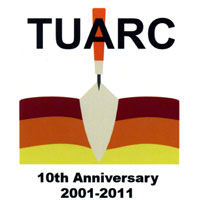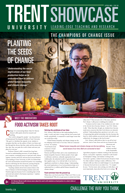 The Trent University Archaeological Research Centre (TUARC) held an open house Wednesday, April 20, to celebrate its tenth anniversary and to showcase its accomplishments over the past decade to faculty, students and members of the public.
The Trent University Archaeological Research Centre (TUARC) held an open house Wednesday, April 20, to celebrate its tenth anniversary and to showcase its accomplishments over the past decade to faculty, students and members of the public. TUARC was established in May 2001, to support archaeological research, to encourage the study of archaeology at Trent, and to educate the public about archaeology and cultural heritage. Dr. Paul Healy, dean of Arts and Science and founding director of TUARC, sees the research centre as the natural outgrowth of Trent’s historical focus on archaeology. “One of the first faculty hired by Trent's founding president and vice-chancellor, Professor Tom Symons, was Dr. Kenneth Kidd, an archaeologist, who was asked by Professor Symons to set up the Anthropology Department,” Professor Healy explained. “Right away we had a focus on archaeology, and we’ve never looked back.”
When TUARC began, it had six members, mostly Trent faculty. It has now grown to 33 members, including independent researchers and private sector archaeologists working in the area of cultural heritage management. “TUARC is part of Trent’s public face to the world,” said Dr. Marit Munson, TUARC director, and associate professor with the Department of Anthropology. “We have members who are spreading out across the globe and doing work in Turkey or in Italy or in Belize. That’s one way to spread the word about what Trent does and to broaden the professional scope of Trent beyond the university.”
According to Professor Munson, one of the goals of TUARC is to support and encourage undergraduate and graduate education in archaeology, and to that end, TUARC offers grants that help fund collaborative research projects between TUARC members and anthropology graduate students at Trent. Alex Nascou, one recipient of a 2010 TUARC Collaborative Research Grant, used his funding to do field research in Quebec under the supervision of Dr. Eugène Morin, assistant professor in the Department of Anthropology. According to Professor Nascou, TUARC plays a key supportive role for archaeology students at Trent, not only through their grants, but through their public lectures and events. “Not everyone in the Anthropology Department is doing archaeological work,” he pointed out, “and TUARC helps us to stay connected and to learn what other people in the department are doing.”
The collaborative research grants are a part of TUARC’s larger program that includes public lectures, workshops, and publications. “While our goals have remained constant over the years,” said Prof. Munson, “we keep coming up with new ways to implement them,” including the public lectures and publications written for the general public. “Through these initiatives,” she added, “we have really become known for bridging that gap between professionals and the public.”
This collaborative approach had been a focus of TUARC’s since its inception. According to Prof. Healy, TUARC was conceived as an interdisciplinary research centre with a focus on archaeology, which would also bring together people from Ancient History and Classics. “Interdisciplinarity is one of Trent’s strengths,” he says. “We wanted to build on what we had in the past and to build an inter-disciplinary focus for this research centre. We really have this tremendous expertise when you pull people from different areas and departments.” According to Prof. Healy, TUARC’s activities, along with the new undergraduate degree program in Archaeology, the graduate program in Anthropology, and the Canada Research Chair in Archaeology held by Dr. James Conolly, create a “synergy” that makes Trent one of the top universities in Canada for the study of archaeology.
Posted on Tuesday, April 26, 2011.


































